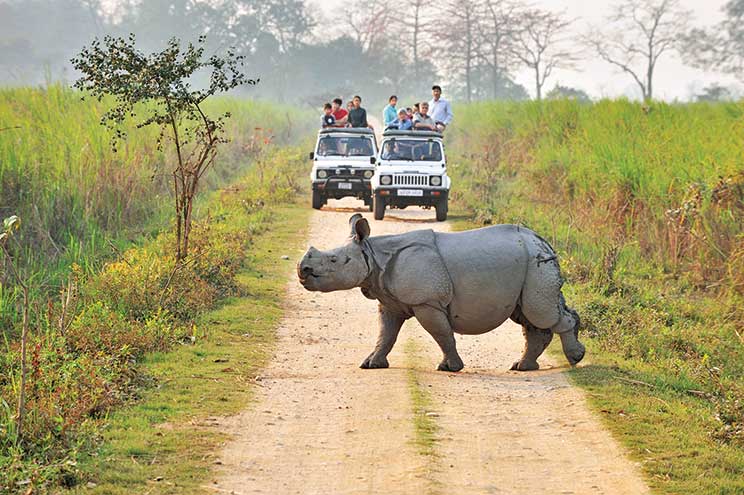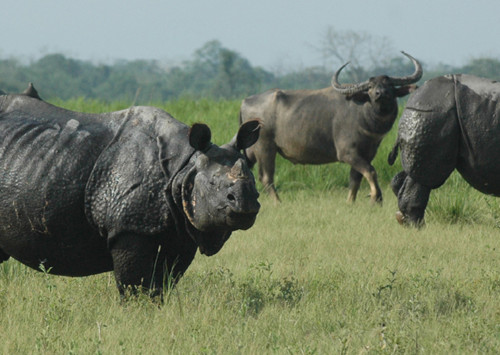Spotting Our One-Horned Friends
India & You
September-October 2018

Famous for its many Indian rhinoceros, the Kaziranga National Park in Assam is more than about the one-horned animals. With its early morning elephant safari and bird watching along with learning sessions at the breeding centre, a visit to the park can be adventurous as well as educative.
It was early morning when we left from Guwahati (capital of the north eastern state of Assam) and mild rays of a winter sun shimmered on the waters of the tributaries of the river Brahmaputra. As we drove towards the Kaziranga National Park through National Highway 37, the landscape evolved with wide dense forested plains and tea gardens on one side, and numerous food joints on the other.
Though India has a lot of regions that are rich in wildlife, few are as densely populated as the Kaziranga. As we entered the forest area, deer and wild buffaloes welcomed us amidst safari jeeps, and souvenir shops filled with rhino T-shirts and clay molds. A world heritage site, the Kaziranga National Park is located on the edge of eastern Himalayan biodiversity hotspots of Golaghat and Nagaon districts. As the story goes, Mary Curzon, wife of the then Viceroy of India Lord Curzon of Kedleston, visited the park hoping to spot Indian one-horned rhinoceros but she couldn’t find even one. She then insisted to take measures to protect the species and Lord Curzon initiated planning for their protection.
“Today, with a 430 sq km area, Kaziranga houses around 70 pc of the world’s one-horned rhino population; i.e., more than 2,200 in numbers,” our guide informed us as we entered the national park. We mounted on top of an open jeep and headed into the core of the forest. Entry into the park is divided through four areas – Mihimukh in Central Range at Kohora, Bagori in Western Range at Bagori, Agaratoli in Eastern Range at Agaratoli, and Ghorakati in Burapahar Range at Ghorakhati.
On entering the reserve through Agaratoli, we were soon surrounded by elephant-grass meadows and dense broadleaf forests. We had barely driven into the forest and a deer family crossed the road in front of our jeep. “These deer are now used to being around humans so they don’t run away after seeing us. Though, we must maintain silence during the safari,” our guide said.
Upon steering deeper into the forest, we again spotted a group of deer who calmly fed on the grass and allowed us to admire them. Soon after, finally, a one-horned rhino was amid the tall grass on our right and our guide signalled us not to make any noise and stay still. We were so close to the rhino that we could clearly see its brown skin folding into its shoulder and back. It fed on the grass for as long as we observed him in his natural surroundings. “The animal is dangerous and confined to tall grass. It has a good sense of smell and hearing but not very good eye sight,” our guide said after the rhino slowly disappeared into the green grass.
Is it just the one-horned rhino?
“A part of the park only has herbivorous animals where wild boars, sambar and hog deer roam freely, without any danger,” the guide further informed us. “The forest is also a good place for bird watching,” he added.
The park is recognised as an important bird area by Bird Life International for the conservation of avifaunal species and our guide helped us spot some – like different types of duck, Asian openbill and barheaded geese.
Kaziranga is also one of the few national parks in the country where visitors can stay at forest rest houses and opt for an elephant safari. Though the area covered by an elephant is much smaller, being perched on an elephants back offers a unique perspective of the jungle – towering trees, quick movements of the crickets and scent of flowers – which you might miss while moving in a jeep.
Conservation at heart
We saw some men at the Centre for Wildlife Rehabilitation and Conservation (CWRC) in Kaziranga emulating a goose. In no time, some little rhinoceros came walking towards him and began to drink the milk that the men were holding. This was the morning feed for rhinos. CWRC is home to several rescued orphan rhinos, who share the centre’s ground with baby elephants, wild buffaloes and swamp deer.
Mind the details:
• Kaziranga National Park remains closed from May-October every year for visitors.
• Visitors have to arrange a transfer for themselves to the elephant point in Kaziranga. Daily elephant safaris run around the central reserve for two hours at sunrise at 5.30 am. During winters it is 6:30 am
• For elephant safaris, bookings need to be done a night prior.
• Fee for a jeep safari is not paid per person. If you are a solo traveller, you pay for the entire jeep. Join a group if you want to pay per person.
• While many luxury hotels and lodges in and around the forest area have Wi-Fi, if you are a budget traveller, your hotel might not have this facility. Here is the catch – visit the tourism information office and sign their guestbook to get complimentary Wi-Fi access.












